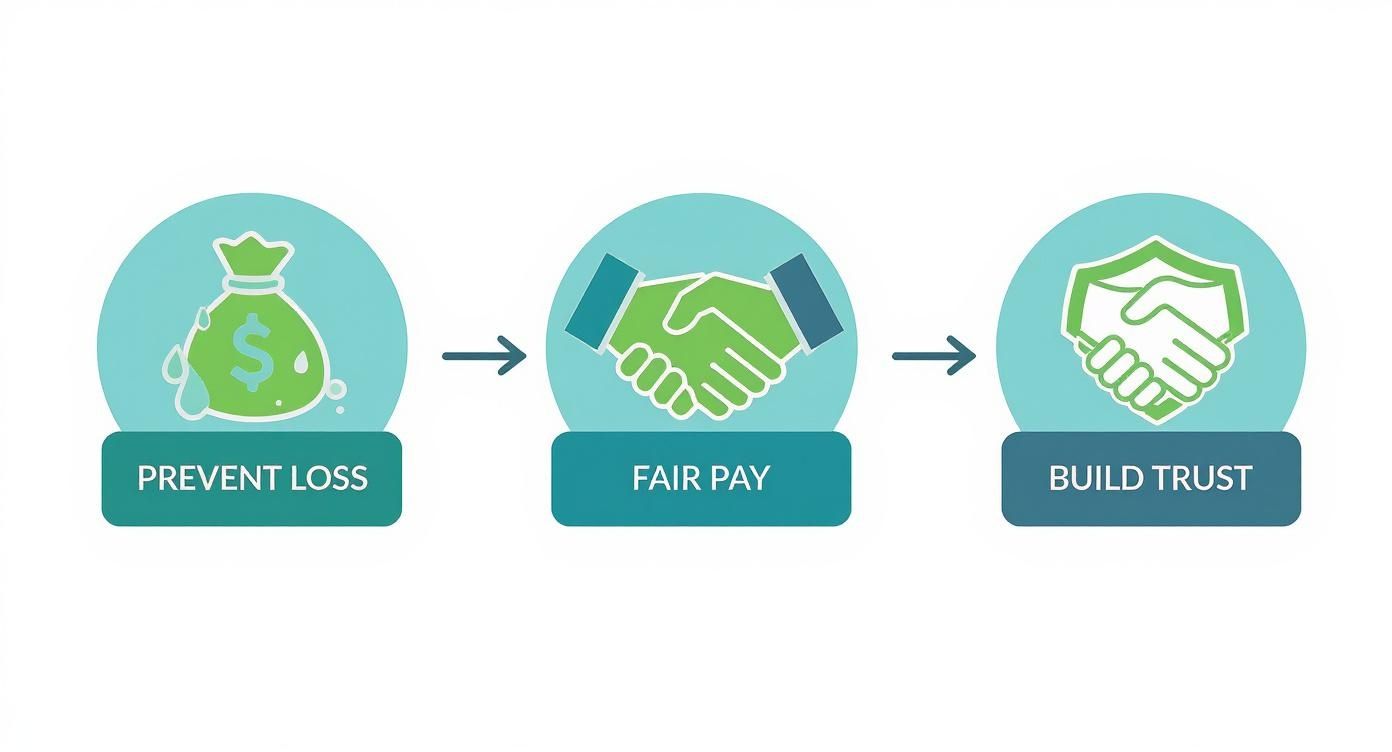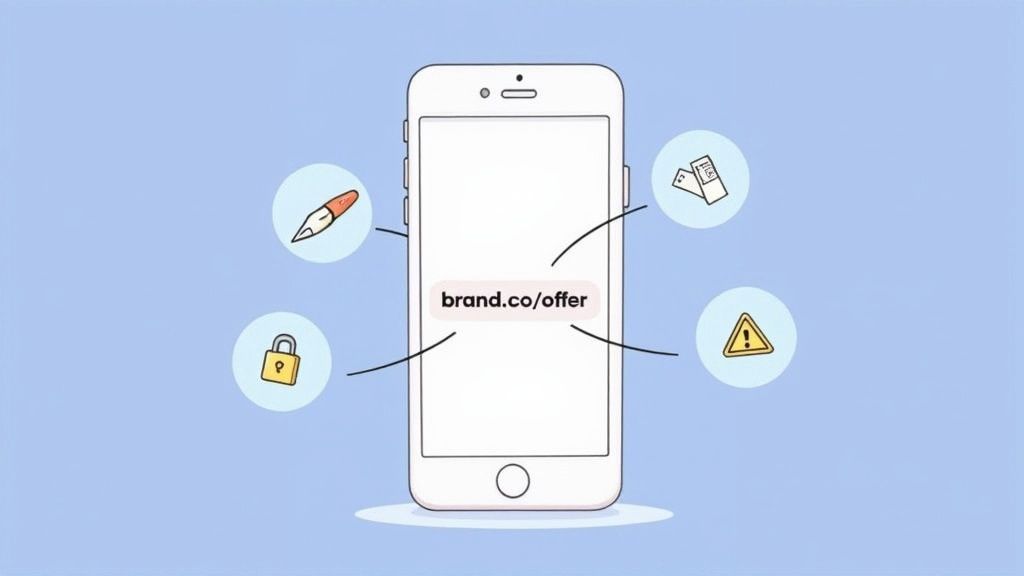- Date
Mastering Tracking Affiliate Links for Better ROI
 Andrii Romasiun
Andrii Romasiun
Trying to run an affiliate program without tracking your links is like throwing money into the wind and hoping it lands in the right place. You’re putting in the effort, but you have absolutely no clue what’s actually working.
When you get tracking right, you stop guessing. You start building a clear, data-driven strategy that shows you exactly which partners, content pieces, and campaigns are actually making you money. It’s the only way to double down on what’s effective and cut the dead weight.
Why You Can't Afford to Guess with Affiliate Links
Successful affiliate marketing goes way beyond just handing out links. It’s about seeing the entire path a customer takes, from their first click on a partner’s site to the final sale. Without a solid tracking system, you're just making assumptions, which is a fast track to wasted ad spend, missed opportunities, and frustrated partners. The real goal here is to get past simple click counts and start measuring what truly matters: performance.
It's a Matter of Money and Strategy
At its heart, accurate tracking is about financial accountability. You need to know that every dollar you put into your program can be traced back to a tangible return. This kind of detailed view is what lets you take control.
For instance, you can:
- Plug Revenue Leaks: Find and fix broken links, pinpoint incorrect attributions, or identify partners who are costing you money without delivering.
- Create Smarter Commission Tiers: Reward your top performers for the value they bring, which gives them a powerful reason to promote you even more.
- Put Your Budget Where It Counts: Shift your resources confidently to the campaigns and channels that bring in the best traffic and the most sales.
This level of precision is more critical than ever. The affiliate marketing industry is hovering around $18.5 billion in 2024 and is expected to rocket past $31.7 billion by 2031. With 81% of brands now running affiliate programs, you can't compete without a data-first mindset. If you want to dive deeper, you can learn more about these affiliate marketing statistics and what they mean for businesses.
Accurate tracking is what builds the trust that turns one-off promotions into powerful, long-term affiliate partnerships. It’s the bedrock of a scalable, profitable program.
Building Stronger Partnerships with Transparency
Let's be real—the numbers are only half the story. Transparent tracking is the foundation of any healthy affiliate program. When your partners see that their hard work is being logged fairly and accurately, it builds a massive amount of trust. That confidence is what motivates them to put more of their own time and resources behind your brand.
It also changes the conversation. Instead of vague chats about performance, you can have honest, data-backed discussions. You can point to specific campaigns that crushed it or fell flat, turning your relationship into a true partnership focused on growing together. At the end of the day, tracking your affiliate links isn't just a technical chore; it's the strategic asset that will drive your program's success.
Building a Solid Tracking Foundation with UTMs
If you're serious about affiliate marketing, you need to get comfortable with UTMs. Think of Urchin Tracking Modules—or UTMs—as little breadcrumbs you attach to your URLs. They tell your analytics software precisely where every single click came from, turning vague traffic data into a crystal-clear map of what's working.
These aren't just vanity metrics. When you combine the different UTM parameters, you get a complete story behind each click. This is the difference between blindly hoping your affiliate program works and actually knowing, with hard data, which partners and campaigns are driving real results.
The Five Core UTM Parameters
Let's break down the five key UTM parameters. You won't always need every single one, but understanding what each does is fundamental to building links that give you truly useful information.
- utm_source: This is the who. It identifies the specific person, site, or platform sending you traffic. For an affiliate, this could be their name or handle, like
toptechreviewerorfacebook_influencer_A. - utm_medium: This is the how. It describes the channel used, such as
social,email,cpc(for paid ads), orblog_post. - utm_campaign: This is the what. It names the specific promotion you're running. Think
black_friday_saleorq2_product_launch. - utm_term: Originally designed for paid search, you can get creative here. Use it to track specific keywords in a blog post or even pass an affiliate's unique sub-ID.
- utm_content: This is your secret weapon for A/B testing. If you have two links on the same page pointing to the same URL, this parameter helps you tell them apart. For example:
blue_buttonvs.header_link.
So, how does this look in the real world?
Imagine one of your top influencers is promoting your Black Friday sale through an Instagram Story. A properly tagged URL would look like this:
yourwebsite.com/product?utm_source=influencer_jane&utm_medium=social&utm_campaign=black_friday_22&utm_content=instagram_story_link
Just from that one link, you know Jane (source) sent traffic from social media (medium) as part of your Black Friday promotion (campaign), and it came directly from her Instagram Story (content). Now you can measure her Story's performance against her feed post or another influencer's efforts.
This level of detail is about more than just data—it’s about building a trustworthy and profitable program. As this infographic shows, it prevents lost revenue, ensures your partners are paid fairly, and creates transparency for everyone involved.

Ultimately, great tracking builds a better ecosystem for you and your affiliates.
Why Consistency Is Your Superpower
Here's a piece of advice I can't stress enough: the real power of UTMs comes from consistency. If you’re messy with your tagging, you’ll end up with fragmented data that's more confusing than helpful. A click tagged with a capitalized Facebook and another with a lowercase facebook will appear as two entirely different sources in your analytics dashboard.
The goal is to create a simple, repeatable system. A shared spreadsheet or a clear naming convention document that your entire team and all affiliates can reference is crucial for maintaining clean, actionable data.
To make this process foolproof, lean on tools that do the heavy lifting for you. For instance, you can create perfectly structured URLs every single time with our free and easy-to-use UTM builder tool. It helps enforce your naming rules and keeps everyone on the same page.
By setting these ground rules from day one, you ensure your data stays organized and reliable, no matter how much your affiliate program grows.
Choosing the Right Affiliate Link Management Tool
Once you've got your URLs tagged with consistent UTM parameters, you’re faced with a new problem: the links themselves are often long, ugly, and intimidating. Nobody wants to click on a messy string of characters and tracking codes. This is where a good link management tool comes in, turning those clunky URLs into clean, trustworthy, and branded links that people actually want to click.
The process is often called link cloaking. It's really just a simple redirect that hides the complicated affiliate URL behind a much shorter, more professional-looking one hosted on your own domain. For instance, a link like yourblog.com/recommends/product-name looks way more appealing than a long, parameter-stuffed URL spat out by an affiliate network.
WordPress Plugins vs. Dedicated Platforms
So, how do you manage these links? You've got two main paths: WordPress plugins or dedicated Software-as-a-Service (SaaS) platforms. The best one for you really boils down to your technical comfort, your budget, and how big your affiliate operation is.
- WordPress Plugins: If your world revolves around a WordPress site, tools like Pretty Links or ThirstyAffiliates are fantastic. They’re often more affordable, and since they live right in your WordPress dashboard, creating and managing links feels like a natural part of your content workflow.
- Dedicated SaaS Platforms: On the other hand, services like Bitly or Rebrandly offer a lot more power that isn't tied to a single website. These are perfect if you're promoting affiliate links across multiple channels—think social media, email newsletters, and different websites—and need one central place for analytics, A/B testing, and team features.
A clean, branded link does more than just look good—it builds trust. Users are far more likely to click on a URL that clearly belongs to a brand they recognize, which can give your click-through rates a serious boost.
Getting this right is more important than ever. In the U.S. alone, affiliate marketing spending hit $9.56 billion in 2023 and is on track to cross $12 billion by 2025. If you want to dive deeper into these numbers, you can explore detailed affiliate marketing statistics. The right tools help you get your slice of that massive pie.
Comparing Affiliate Link Management Methods
To help you visualize the differences, here’s a quick breakdown of the common methods for shortening and managing affiliate links.
| Method | Pros | Cons | Best For |
|---|---|---|---|
| WordPress Plugins | Integrates directly into your workflow; cost-effective; keeps links on your own domain. | Tied to a single WordPress site; can slow down your site if poorly configured. | Bloggers and businesses whose primary platform is a single WordPress website. |
| SaaS Platforms | Centralized dashboard for all channels; advanced analytics and A/B testing; not tied to one site. | Monthly subscription fees; can be overkill for simple needs. | Businesses promoting across multiple channels (social, email, multiple sites). |
| Manual Redirects | No extra software needed; complete control over your .htaccess file. | Highly technical; prone to errors; no built-in tracking or management interface. | Developers or tech-savvy marketers with very few links to manage. |
Ultimately, choosing a method comes down to balancing convenience, cost, and the features you absolutely need for your specific affiliate strategy.
Finding the Best Fit for Your Program
To make the right call, think about the scale and complexity of what you're trying to do.
If you’re a blogger just dipping your toes into affiliate marketing on a single WordPress site, a plugin like Pretty Links is a no-brainer. It's cost-effective and handles the core job of cloaking and basic click tracking without a bunch of features you'll never use.

However, a larger business juggling dozens of affiliates across multiple platforms would quickly outgrow a simple plugin. In that scenario, a dedicated SaaS tool is the way to go. The ability to see performance data from every channel in one dashboard, create branded short domains, and manage user access is crucial for staying organized and scaling up. This kind of centralized approach to tracking affiliate links breaks down data silos and gives you a complete picture of your affiliate ecosystem, empowering you to make smarter, faster decisions.
Using Analytics to Uncover Actionable Insights
So you’ve created perfectly tagged URLs. That's a great start, but it's really only half the battle. The real magic in tracking affiliate links happens when you turn all that raw data into a clear story about what’s actually driving your business. Without this step, you’re just collecting numbers. With it, you’re making smart, strategic decisions that directly boost your bottom line.
This is where a solid analytics platform becomes your command center. Instead of drowning in a sea of clicks and pageviews, you can link your UTM data directly to user behavior and, crucially, to conversions. It's about moving past vanity metrics and zeroing in on the actions that truly matter.
Locating Your Affiliate Data in Swetrix
If you're using a privacy-first tool like Swetrix, finding your campaign data is a breeze. The entire platform is designed to give you clear information without being overwhelming. You can immediately see how traffic from different sources and campaigns behaves once it lands on your site.
The dashboard gives you a clean, high-level overview of your traffic sources. Think of this as your starting point for digging deeper to see which affiliates are sending you the most engaged visitors.

From here, you can drill down into specific reports to isolate the performance of each affiliate campaign, source, or even a single piece of content.
The real goal is to filter these reports using the UTM parameters you worked so hard to set up. By isolating traffic from a specific utm_campaign, like black_friday_22, you can see exactly how that promotion performed. This is perfect for comparing different affiliates' contributions within the very same campaign.
The most valuable insights don't come from just looking at clicks. They come from analyzing what happens after the click. Are visitors from a certain affiliate bouncing right away, or are they sticking around and completing your conversion goals?
Moving Beyond Clicks to Analyze Performance
Answering these questions is how you uncover your true star performers. A huge click count from an affiliate looks great on paper, but it doesn't mean much if none of those visitors ever convert. Real performance analysis is all about connecting traffic sources to meaningful outcomes.
Here’s a practical way to break down this analysis:
- Filter by Source: Start by isolating traffic from one affiliate (e.g.,
utm_source=toptechreviewer). Now, check out their metrics. Is their conversion rate for your "sign up" goal higher than average? - Compare Campaigns: Next, filter by a campaign tag (e.g.,
utm_campaign=q2_launch) and then segment that data by source. This will show you exactly which affiliate was most effective at promoting that specific launch. - Analyze User Behavior: Take a look at the user flow for traffic coming from a high-performing affiliate. Which pages do their visitors interact with the most? This can offer incredible clues about what content resonates with their specific audience.
This level of detail transforms your data from a simple report into an optimization playbook. You might find that one big-name affiliate sends tons of traffic but almost no sales, which points to a mismatch in audience expectations. At the same time, a smaller affiliate might send less traffic but have a significantly higher conversion rate, making them an infinitely more valuable partner.
If you want to dive deeper into connecting these dots, we have a whole guide on turning analytics into actionable insights.
By making this kind of data review a regular habit, you can have data-backed conversations with your partners, fine-tune your commission structures, and confidently put more resources behind the affiliates who deliver genuine results.
Navigating a Future Without Third-Party Cookies
Let's face it: the world of digital marketing is undergoing a seismic shift. For years, affiliate marketers have depended on third-party cookies to attribute sales, but that era is coming to a close. With privacy regulations getting stricter and browsers like Chrome phasing out these cookies, the old playbook is officially obsolete.
This isn't just a small bump in the road. It’s a fundamental change that demands we rethink how we track affiliate links. We have to move past unreliable, browser-based methods and adopt strategies that are not only more accurate but also respect user privacy.
The upside? This forced evolution is pushing us toward a much healthier and more sustainable way of doing business. By embracing methods that don't rely on invasive third-party data, we can build stronger, more trusting relationships with our audience while staying compliant with rules like GDPR and CCPA.
Embracing First-Party Data and Server-Side Tracking
The most reliable path forward is to use tracking methods you have direct control over. This is where server-to-server tracking—often called postback tracking—really shines.
Instead of dropping a cookie on a user's browser and hoping for the best, this method generates a unique click ID for every interaction. When a conversion happens, that ID is passed directly from your server to the affiliate network's server. It’s a clean, direct line of communication that’s nearly impossible to block, ensuring your data is rock-solid.
At the same time, you need to be making the most of your first-party data. This is the information you collect directly from your audience with their consent, like through email sign-ups or customer accounts. This data is a goldmine for understanding the real customer journey.
Embracing privacy-centric tools and first-party data isn't just about avoiding fines—it's about building the consumer trust that separates successful brands from the rest in a privacy-conscious world.
With the end of third-party cookies, smart marketers are pairing these strategies with AI-driven automation to get a clearer picture of their campaigns. As a recent analysis from IMD Business School highlights, integrating data-rich platforms is key to analyzing complex, multi-channel customer journeys and ensuring affiliate marketing continues to thrive.
The Practical Shift to Privacy-First Analytics
Making this transition isn't just about the tracking method; it's about the tools you use to analyze the results. You need an analytics platform that was built for this new reality—one that gives you the insights you need without resorting to invasive techniques.
This brings us to cookie-less tracking. It's a modern approach to gathering essential analytics while putting user consent first. If you're ready to make the switch, our guide on setting up cookie-less tracking is the perfect place to start.
Ultimately, this new era isn't a roadblock. It's an opportunity to build a more transparent, effective, and resilient affiliate program.
A Few Common Affiliate Tracking Questions
Even with a rock-solid setup, you're going to run into weird situations and tricky questions. It's just part of the game. Let's walk through some of the most common issues I see people face, so you can handle them like a pro and keep your affiliate program humming along.
What If an Affiliate Disputes My Tracking Data?
This one comes up more often than you'd think, but it doesn't have to turn into a fight. When a partner questions your numbers, the first step is always to get on the same page. Hop on a call and pull up your analytics dashboard right alongside theirs.
Nine times out of ten, the discrepancy is hiding in plain sight.
- Attribution Windows Don't Match: You might have a 30-day cookie window, but their system could be set to 60 days. That difference alone can cause a major mismatch in conversion counts.
- Timezone Troubles: A simple timezone misalignment can make daily or weekly reports look completely different. Make sure you're both looking at data from the same 24-hour period.
- Bot & Junk Traffic: Your analytics might be doing a great job filtering out fraudulent clicks, while their system counts every single one. This is a classic reason for a gap in click data.
By calmly walking through these settings together, you'll almost always find the culprit. It's actually a great way to build more trust with your partners.
Why Do My Affiliate Links Keep Breaking?
Ah, the dreaded "link decay." You spend all this time setting up the perfect links, only to find they've stopped working a few months later. It’s a huge pain.
Usually, it happens for a couple of reasons. The merchant might have redesigned their website and changed up their entire URL structure, or the product you were linking to is now out of stock or discontinued.
My advice? Schedule a quarterly link audit. Seriously, put it on your calendar. Use a broken link checker to scan your site for dead affiliate links. Fixing them proactively not only saves you from losing revenue but also keeps your site experience smooth for visitors, which is great for SEO.
Do I Really Need to Cloak My Affiliate Links?
I get this question all the time. Can you just use the raw, long affiliate link the network gives you? Sure, you absolutely can. But should you? Probably not.
Cloaking your links with a tool like Pretty Links offers some massive advantages. It turns an ugly, untrustworthy URL into something clean and professional, like yourbrand.com/recommends/product.
This isn't just about looks. A clean link gets more clicks because people trust it more. Plus, it makes managing your entire link portfolio a breeze. If a merchant changes their links, you only have to update it in one place instead of hunting it down across dozens of articles. Think of it as a bit of organizational work upfront that saves you a ton of headaches down the road.
Ready to get clear, actionable insights from your website traffic without compromising user privacy? Swetrix offers powerful, cookie-less analytics designed for modern marketers. Start your 14-day free trial and see what you've been missing.